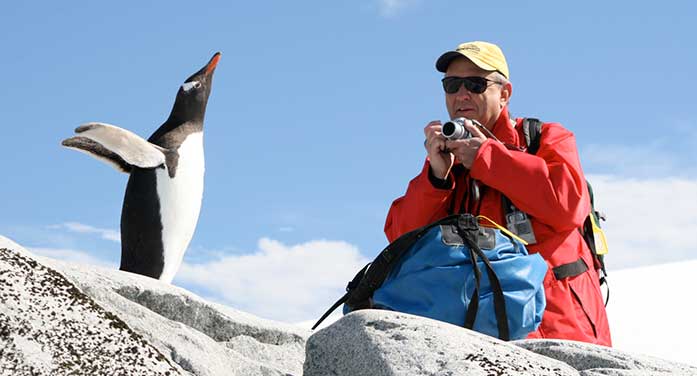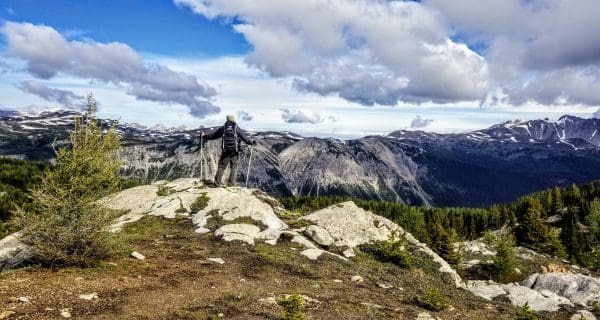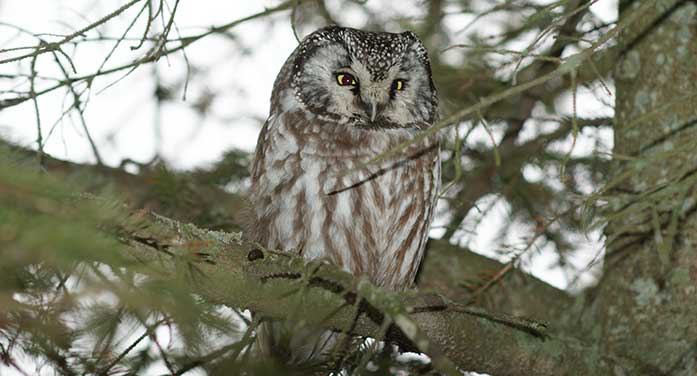
Geoff Carpentier getting a few shots of a gentoo penguin in Antarctica. When doing this, it’s important to quickly take one or two photos and then leave
 I sometimes wonder how people with disparate desires share a common resource while respecting other people’s differing ideals and goals.
I sometimes wonder how people with disparate desires share a common resource while respecting other people’s differing ideals and goals.
I’m a dedicated birdwatcher, as I think you might have figured out by now. Years ago, I went to Rondeau Provincial Park in Ontario to look for a very rare bird – a sage thrasher from the deserts of the southwestern United States.
The walking path to see the bird was about 11 km round trip, and the bird was naturally at the halfway point, so there were no shortcuts. It took a while to get there, and when I did, the bird wasn’t in sight, nor did it reappear while I was there.
But realizing this is the way with nature, I accepted my fate and was about to head back when some fishermen in a boat just offshore asked what I was doing. I told them and they asked if I saw the bird. When I said I didn’t, they said, “Well, wasn’t that a stupid thing for you to walk all the way out here to look for a bird?”
|
Related Stories |

|
| Hut-to-hut hike rewards adventurers with epic views
|
| A whale of a shift in seasons on the West Coast
|
| An epic fishing adventure at the Arctic Circle
|
I was a bit surprised but replied, “What are you doing?” When they said they were obviously fishing, I asked how many hours they had been out there (six) and had they caught any fish (no). I then commented that perhaps what they were doing was no more stupid than what I did. They agreed and we all laughed, suddenly recognizing how our perspectives controlled our outlooks.
The point is that how and when we use nature is our business (to a point) and what we want out of the adventure can be very different than what others want.
Take a woodlot, for example. If you go there, do you want to photograph flowers, look for birds, stroll in solitude, pick mushrooms, walk your dog, hunt or ride your mountain bike? All take place in the same location, sometimes at the same time, but the goals of each participant are very different, and the impacts they cause are likewise different and sometimes incompatible.
Conflicts often arise when someone does something we think is wrong, but who are we to judge?
One example that annually arises is the ‘harassment’ of wildlife by photographers. I say this tongue in cheek, for I take pictures and others I know do as well. I don’t for one second mean to imply that everyone who takes pictures of birds or mammals is doing anything wrong. But how we do it and our impact on wildlife must be factored in.
Owls are preferred targets for photographers. There are some great ways to do this and some not-so-great ways. I’ve written about this before, but any negative impact is too much. If you stay back, enjoy the bird, let it hunt or sleep, everybody and everything wins.
In the last few days, a ‘celebrity’ owl was spotted in Stoney Creek, Ont. that attracted hundreds of photographers and birdwatchers. Almost everyone behaved and saw the bird, quickly took one or two photos and left. Others stayed for hours and came back day after day to get more photos and talk about the bird. The owl was quite stressed as a result.

Owls, like this Boreal, photographed on Amherst Island, Ont. are preferred targets for photographers. But there are some great ways to do this and some not so great
One gentleman decided the bird wasn’t co-operative enough, so he banged on the tree with a stick to wake the owl so he could get photos of the now-alert bird. This is unacceptable. For most of those who saw the bird, it was a peaceful and enjoyable experience that didn’t harm the bird. The balance was broken by one overzealous person who put his needs above the well-being of the owl.
Whether you hunt, fish, ride, walk, birdwatch or photograph, there’s enough wildlife and wild places for all of us to share. Who are we to say someone else’s passions are wrong?
The only time we need to stand up is when someone’s actions negatively impact nature. Respect each other, but above all, please respect nature.
Geoff Carpentier is a published author, expedition guide and environmental consultant. Visit Geoff on LinkedIn, Instagram and Facebook.
For interview requests, click here.
The opinions expressed by our columnists and contributors are theirs alone and do not inherently or expressly reflect the views of our publication.
© Troy Media
Troy Media is an editorial content provider to media outlets and its own hosted community news outlets across Canada.



From the author: So there are no misconceptions by the readers of this article, I did not approach this penguin in the top photo – it came to check me out. Generally you are not allowed to approach within 5 or 10 meters of wildlife (and in some cases more) in Antartica, but wildlife can come as close as they want!
From the author: So there are no misconceptions by the readers of this article, I did not approach this penguin in the top photo – it came to check me out. Generally you are not allowed to approach within 5 or 10 meters of wildlife (and in some cases more) in Antartica, but wildlife can come as close as they want!